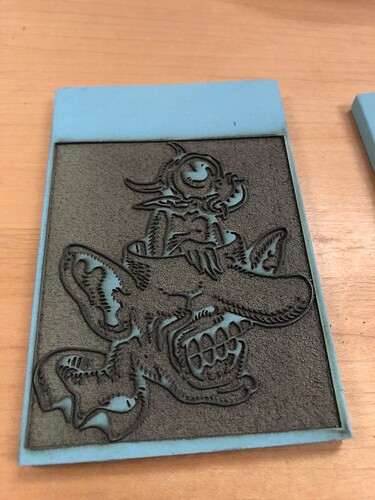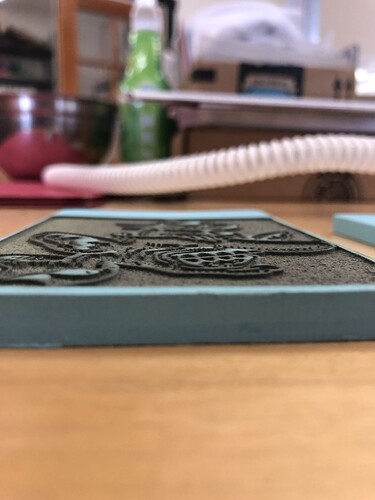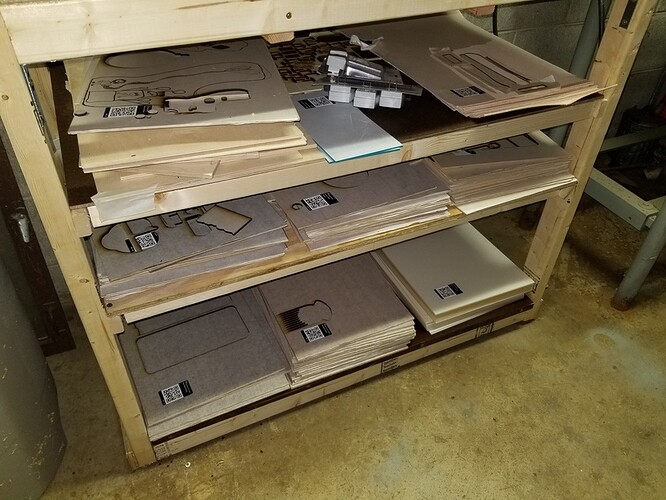Hi, It was around 4 days to be delivered! Didn’t take that long!
Thanks. I’m getting some now - good for stock !

What was the depth of the material used here?
Hi Lizabeta, I’ve used a 2.3mm
This stuff is the RUS001 from Johnson Plastics, with a thickness of .09".
What lines per inch did people use?
(I’m going to try 225, the default… assuming that’s what was used)…
That’s what I used. Two passes was key.
Well…how’s it work!! 
Hi All – just browsing the forums and came across this post about laser cutting rubber. First, very cool designs and ideas, so kudos for the creativity and follow-through. Second, I wanted to offer a PSA for the community… A few years back I looked into cutting various rubbers and discovered that many of them have chlorine as part of their molecular structure. The rule of thumb is that when chlorinated rubbers burn they emit chlorine gas, which is super-duper toxic. Even under well-ventilated conditions, you need to be super careful about it. Moreover, if you generate enough chlorine gas, it can lead to corrosion. For the project I ended up working on, I was able to find chlorine-free rubbers, but I was surprised how hard it was. For folks around here that might not have the opportunity to talk to EH&S experts at work, please be careful when working with rubbers!
That’s why we use laserable rubber blanks…
Good advice… safety with rubbers…thanks for the tips…
@DesignsByPhil – ::facepalm:: D’oh!
That said, for the folks who haven’t had much experience with mandated EH&S lab safety training in their lives and are working as an at-home hobbyist, it’s good standard practice to look up the chemical composition of new plastics/rubbers/elastomers/etc before buying just to make sure chlorine gas isn’t going to be a problem.
[unrelated side note – I haven’t gotten any of the PG acrylics yet, but to my mind, one of the advantages of purchasing through the GF store is that a lot of the chemical safety issues including burnt plastics or burnt wood treatments are presumably addressed behind the scenes at GF when they picked items to stock in the catalog of materials. ]
What about Lines Per Inch - what was that setting you used?
Thanks,
Jen
Hi,
thanks for sharing your expediences in engraving stamps.
I’m using a 3.2mm version of this rubber to engrave my stamps. The engraving goes pretty well and I’m really pleased with the results. But I’m not able to get the rubber cut.
Has anyone experience with the thicker version of that material and was luckier to figure out the propper setting?
Cheers,
telegnom
thanks for this ! i was wondering how to make the software cut everything but the letter
Thank you for these settings!! I found I needed a third pass (or slightly slower speed) for cutting, and that I could get away with a much lower LPI for the second pass of engraving!
You’re welcome!
I am trying to do large stamps like you show here. It’s all broken up in the discussion. I was hoping you could send me the material you used and it’s thickness, including where you bought it so I know which material to use. I have amazon orange, low odor Johnson , and a laserable rubber mat from amazon. Could you tell me the settings you used also? I don’t use files so I don’t need that info. I use my drawings like I am doing a Lino cut. One of these days I will need to learn how to do files, but for now, I keep on finding more and more that works. Would really appreciate this. Thanks
As an Inkscape user can you help me know which command is comparable to “outer glow” in photoshop? I am trying to make rubberstamps with some fine text that needs to be “built up” (ie have sloped slides to provide a little support).



